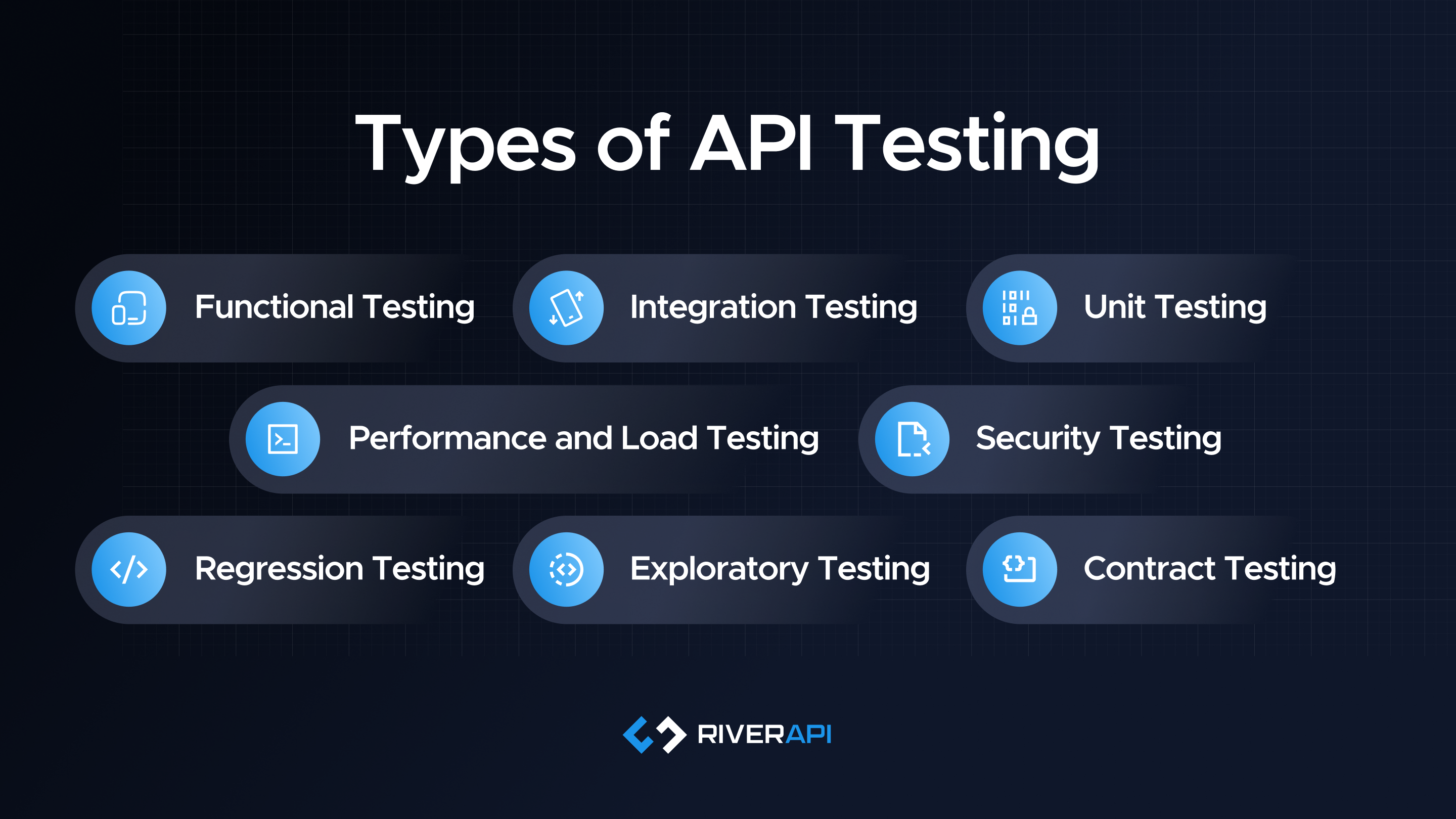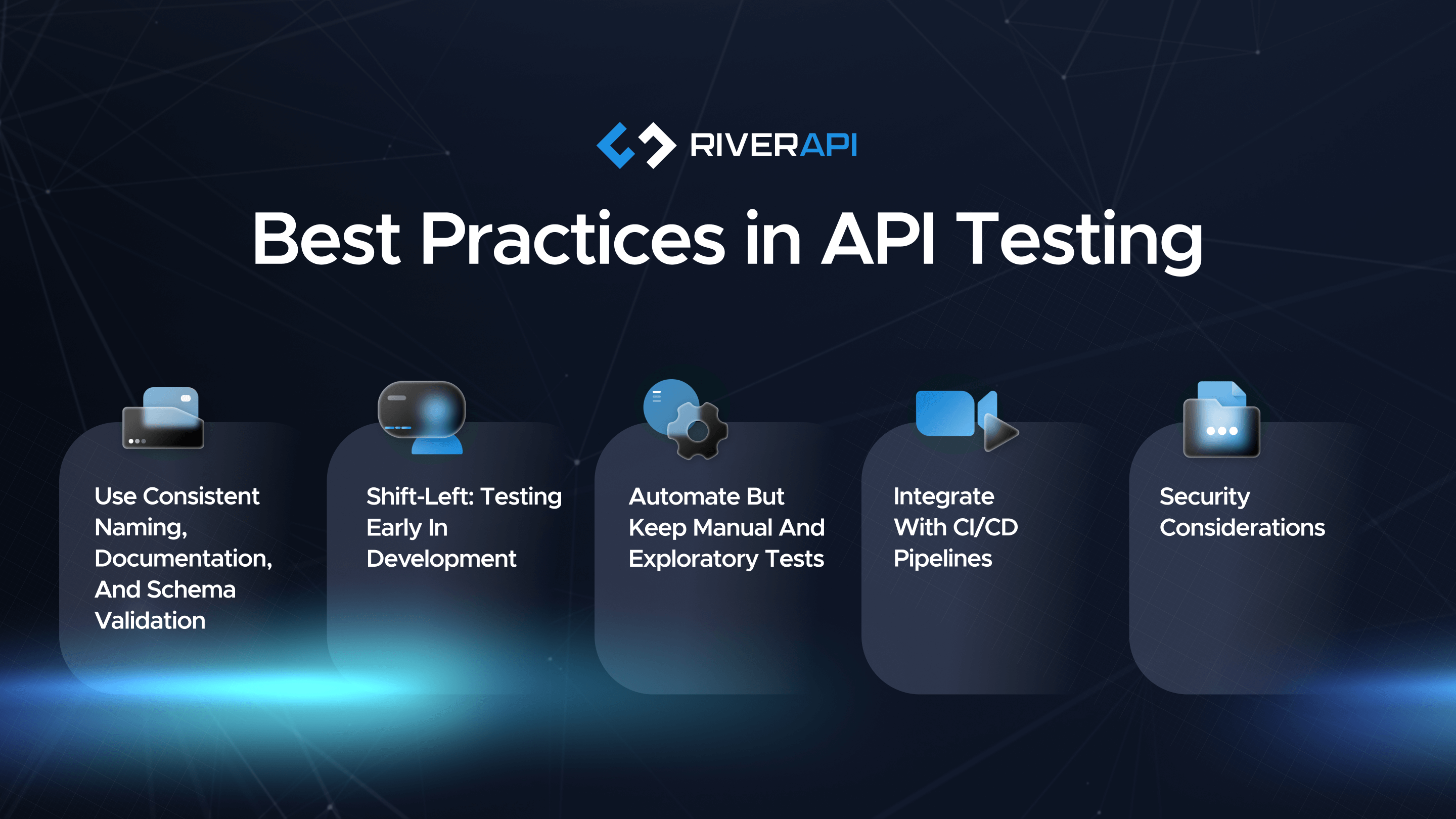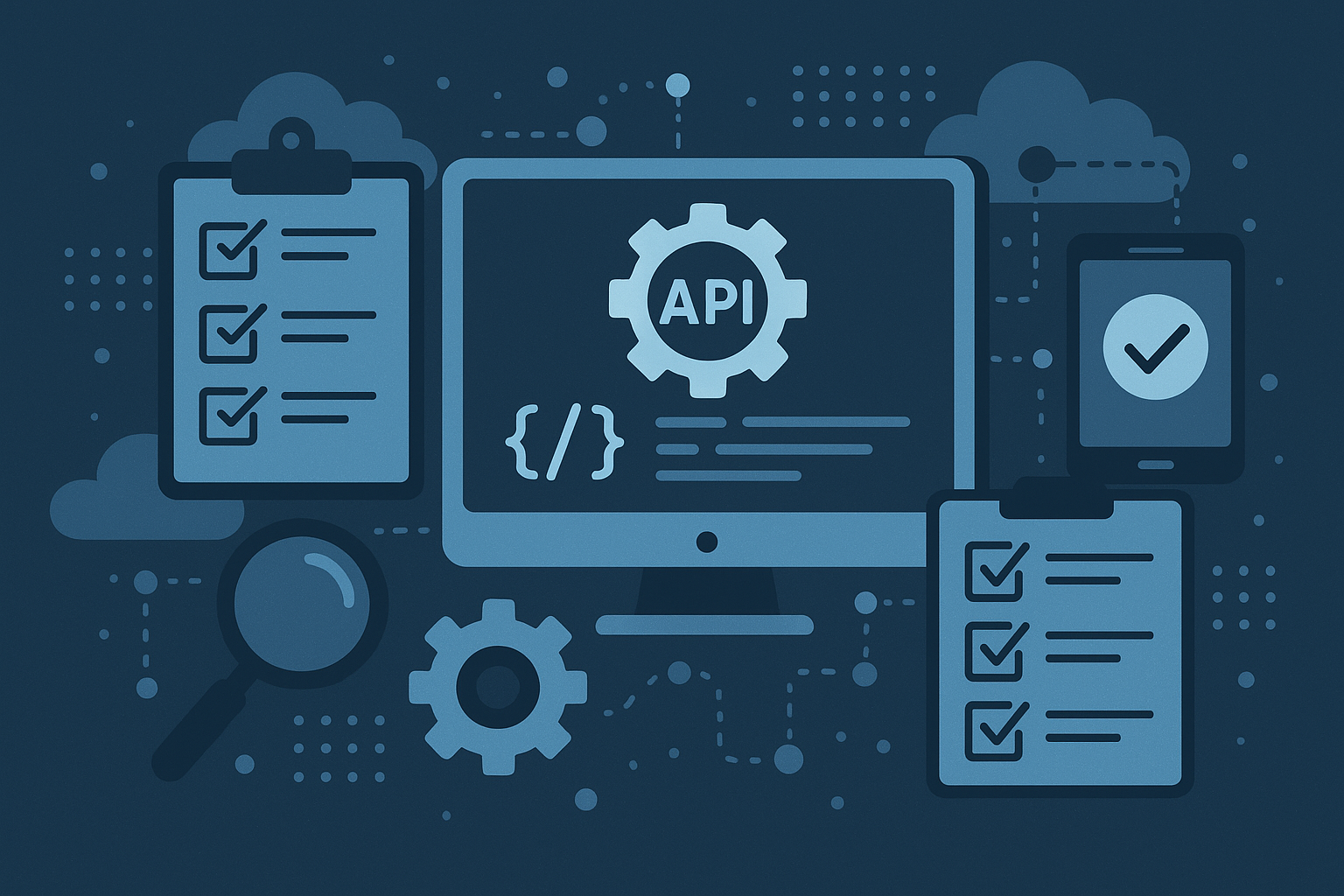Organisations rely on testing and automated endpoint validation to ensure these connections are dependable and secure. This RiverAPI experts guide explains a test, why it matters, and how to apply effective practices in modern development.
What is an API Test and Why API Testing Important
Testing validates how a service works, ensuring it delivers the right responses, handles errors correctly, and remains secure and reliable across environments. Unlike UI testing, which checks visual interactions, the application interface focuses on the communication layer powering modern digital products.
Key Aspects of API Testing
- Functionality: Verifies that endpoints, parameters, and workflows behave as expected.
- Reliability: Confirms that the application interface returns consistent results and handles invalid inputs gracefully.
- Performance: Measures response times, throughput, and stability under normal and heavy loads.
- Security: Checks authentication, authorisation, and data protection to guard against vulnerabilities.
- Integration: Ensures application interfaces work seamlessly with databases, services, and third-party systems.
Why it Matters
- Prevents failures and bottlenecks before production.
- Protects sensitive data by detecting vulnerabilities early.
- Improves user experience by ensuring uptime, speed, and reliability.
- Reduces costs through early bug detection and re-test of existing functionality.
API Testing and API Monitoring: Ensuring Reliability Across Systems
Testing and monitoring complement each other to keep digital systems stable, secure, and high-performing. Testing validates the quality of an integration before it goes live, while monitoring ensures that the same quality is maintained once the service is in production.
Interface testing focuses on functionality, performance, and security before release. It checks whether endpoints return the right data, handle errors correctly, and integrate smoothly with other systems.
API monitoring continues the job after release. It tracks the health and availability of connections in real time, alerting teams when response times slow down, endpoints fail, or unusual behaviour occurs.
By uniting testing and monitoring, organisations create a full lifecycle safety net from pre-release validation to ongoing performance assurance.
When Combined, The Two Deliver Powerful Advantages:
- Prevents defects from reaching production
Testing catches functional and security issues early, reducing risks and costs before deployment.
- Detects and resolves real-world issues quickly
Monitoring provides continuous oversight and immediate alerts, helping teams fix problems before users are affected.
- Ensures long-term reliability, security, and trust
Together, they protect uptime, safeguard data, and keep user experiences consistent.
Types of API and Relationship between Api Testing and Modern Digital Services
An Application Programming Interface is a set of rules and protocols that define how different software systems communicate. APIs enable data exchange, feature access, and integrations across platforms. Proper API testing important to ensure these connections work reliably and securely.
Types of Interfaces
- Public Interfaces: Shared openly with external developers to encourage integrations, such as payment gateways or mapping services. Testing effectively validates these endpoints to ensure correct functionality.
- Private Interfaces: Restricted to internal use within an organisation, often for connecting backend services. Api testing requires careful planning to maintain internal system integrity.
- Partner Interfaces: Shared with select external partners under controlled agreements. Testing is the process used to confirm that integrations behave as expected in real-world scenarios.
Architectural Styles: REST is the most common lightweight style, SOAP uses strict protocol-based communication, GraphQL allows flexible and precise data queries, and gRPC is optimised for speed in distributed systems. The type of testing may vary depending on the architecture to ensure full coverage.
Key Elements
- Endpoints: The specific URL paths where resources can be accessed. Proper test suites for each service ensure endpoints respond correctly.
- Requests: The actions a client sends to the service, such as retrieving or submitting data. Api testing is faster when automated tools simulate these requests.
- Responses: The results returned by the service, often in JSON or XML format. Automated test execution can validate responses efficiently.
- Methods: Standard operations such as GET (retrieve), POST (create), PUT (update), and DELETE (remove). Api testing effectively confirms that methods execute as intended.
- Headers: Information passed along with requests and responses, including content type and authentication tokens. Testing ensures headers are handled properly.
- Payloads: The request body contains data sent to the service, such as user details or transaction information. Errors found in api in payloads can be detected early through structured testing.
Exploring Different Types of API Testing for Quality Assurance
API testing is performed using multiple approaches, each focusing on a specific aspect of quality. Combining different types of API testing ensures that the API works as expected, is secure, and meets both functional and non-functional requirements. Testing occurs throughout the development lifecycle, from early unit checks to production monitoring. API testing plays a crucial role in maintaining high-quality APIs and preventing failures in live environments.

Functional Testing
Functional testing analyses API behaviour by checking that endpoints return the expected output and handle errors correctly. This type covers both valid and invalid requests and ensures that business rules are enforced. Cases for API testing often include verifying standard workflows, input validation, and error handling. Testing the API layer effectively identifies mismatched requirements and broken endpoints before release.
Integration Testing
API integration testing verifies that the API communicates properly with databases, services, or other components. It ensures that data flows correctly between systems and that dependencies do not introduce errors. Test across multiple services to confirm seamless coordination in complex software test environments.
Unit Testing for API Functions
API unit testing focuses on individual methods or modules. It confirms that small logic pieces behave as intended before being combined with other components. The API testing process requires carefully defined test cases within each module to provide early feedback and prevent cascading errors.
Performance and Load Testing
Performance and API load testing measure response times, throughput, and system behaviour under heavy traffic. Sending large volumes of requests to the API ensures that the system maintains reliability and responsiveness. Testing is the process that validates scalability under real-world conditions.
Security Testing
API security testing detects vulnerabilities such as broken authentication, data leaks, and injection attacks. Security testing guarantees the API layer remains robust against external threats and protects sensitive data.
Regression Testing
Regression testing confirms that updates or new features do not break existing functionality. API tests within regression suites are often automated, providing repeatable checks to maintain stability and reduce manual effort.
Exploratory Testing
Exploratory testing involves manual, unscripted testing to uncover unexpected behaviours or hidden bugs. This method is especially useful for new APIs or areas lacking documentation, allowing testers to adapt cases for API testing in real time.
Contract Testing
Contract that the API matches its specification, often defined using OpenAPI or Swagger. By test an API against agreed standards, teams can maintain stable integrations and prevent breaking changes.
Selecting the Right API Testing Tool for Your Workflow
Choosing the right API testing tool is critical for creating reliable, automated, and scalable test processes. A good tool simplifies manual checks, supports test automation, performance validation, and integration with modern CI/CD workflows. Testers and developers use these tools to design test cases, run calls, validate responses, and monitor systems. While dozens of alternatives exist, certain features make some tools more powerful and suitable than others.
What Makes a Good API Testing Tool
A strong testing tool should provide flexibility for both beginners and advanced users. It must support different protocols such as REST, SOAP, and GraphQL, while also allowing complex assertions on responses. Ease of use matters, but scalability is equally important, as teams often move from manual testing into test automation. Good tools also integrate seamlessly with version control systems, CI/CD pipelines, and bug trackers to streamline the entire testing process.
Popular Tools

- Postman
One of the most widely adopted tools for API testing. It allows teams to design collections of API requests, validate responses, run automated suites, and integrate tests into CI/CD workflows. Postman also supports collaboration, making it easy for developers, testers, and product owners to work together.
- SoapUI
A mature solution for SOAP and REST APIs, known for its advanced scripting capabilities and performance testing features.
- Katalon Studio
Provides built-in automation, data-driven testing, and integration with Selenium or JUnit.
- Rest Assured
A Java-based framework often used for integration into existing units and re-testing of existing functionality suites.
- JUnit / NUnit with libraries
Useful when developers want to write tests directly in code as part of their development pipelines.
Features to Look For
- Automation support: Ability to build automated suites that can run without manual input.
- Load testing: Tools that simulate concurrent users and requests to check how it can handle stress.
- Security testing: Features for identifying vulnerabilities such as injection, authorisation gaps, or insecure tokens.
- CI/CD integration: Smooth compatibility with Jenkins, GitHub Actions, or GitLab CI to implement API testing in continuous delivery.
Benefits of API Testing for Businesses and Developers
API testing is crucial for ensuring stability, performance, and security, helping organisations save costs, build trust, and deliver better digital experiences. Comprehensive API testing helps teams validate that every endpoint is working as expected.
Early Bug Detection and Cost Savings
Finding issues early during testing to check for errors reduces the cost and impact of fixes, prevents downtime, and avoids wasted resources. Executing tests in the early stages of the lifecycle ensures problems are identified before they affect production.
Improved Reliability and User Experience
Stable APIs enable smooth communication between services, improving uptime and ensuring a consistent user experience. Continuous testing confirms that its works correctly and supports software development by maintaining reliable integrations across platforms.
Verify API Functionality Before Production
Testing before deployment ensures the API is working, handles errors gracefully, and integrates properly with other systems. An effective api testing strategy guarantees that each behaves as expected across different stages of the API.
Compliance and Security Assurance
API testing involves penetration testing and validation of authentication, encryption, and authorisation policies, helping organisations detect security vulnerabilities and meet compliance standards.
Automated Testing at Scale
Implement API test scripting to make testing repeatable and scalable. Testing tools and frameworks like the Postman API platform allow teams to perform API test automation, execute API tests efficiently, and integrate them into development and testing workflows.
Choosing What to Automate
Functional, security, regression, and API load testing are ideal candidates. Automation supports testing to check endpoints across the stages of the API lifecycle, making continuous testing more effective.
Building Effective Test Suites
Test APIs with functional, error-handling, boundary, and security validations. Suites can be organised by core functionality, authentication, and performance to ensure comprehensive API testing.
Maintaining Tests as APIs Evolve
Regular updates ensure automated test suites stay relevant as APIs change, reduce false positives, and provide meaningful feedback, reinforcing the relationship between testing and long-term software development success.
Case Study: Real-World Success with Postman API Test
To demonstrate how API testing works in practice, consider a QA team using Postman to build and run a test suite. Postman provides a user-friendly interface combined with automation features, allowing testers to better understand API testing and ensure that APIs behave as expected.
Example: Conducting an API Test Suite in Postman
The team creates test suites for each API endpoint of a payment system. Each request is validated for correct response codes, accurate data output, and proper error handling when invalid input is provided. API functional testing ensures that the API functions correctly across a variety of API calls.
Combined Functional, Performance, and Security Testing
Testing plays a crucial role in validating API quality. The same test suite is extended with load tests to simulate high traffic and security tests to verify authentication, encryption, and rate limits. By combining functional, performance, and security assessment in one workflow, the team ensures the API is reliable and secure before deployment. API testing can detect potential failures and prevent issues in production. By implementing automated API tests, developers can quickly verify that the API is working as expected across all endpoints and environments
API Testing Strategy, Test Automation, and Common Pitfalls

A strong API testing strategy reduces errors, saves costs, and makes API integrations scalable. Following these practices helps teams create maintainable, high-quality tests:
Keep APIs Well-Documented
Maintain consistent documentation with schemas, naming conventions, and examples. Use standards like OpenAPI or Swagger to validate requests and responses, ensuring that API behaves as expected.
Test Beyond the Happy Path
Include edge cases, invalid inputs, missing parameters, and incorrect authentication. API testing can help identify vulnerabilities and ensure that API functions correctly in all scenarios.
Plan for Performance and Scalability
Run load and stress tests under varying traffic. Testing early in the development cycle helps ensure API quality and responsiveness once the API has been deployed.
Make Security a Priority
Test authentication, authorisation, encryption, and rate limits. Validate error handling to prevent security gaps. API tests can also reveal weaknesses before they impact users.
Manage API Versions Carefully
Use versioning and contract testing to maintain stable integrations while shifting testing left in the development process.
Automate Wisely, Retain Human Insight
Testing can be automated for regression, integration, and performance checks, while exploratory testing allows teams to adapt to new or undocumented areas.
Integrate Testing into Development Workflows
Incorporate API tests into CI/CD pipelines to catch issues early and maintain continuous quality.
Monitor Continuously
Combine automated testing with ongoing monitoring to detect real-world issues, ensure uptime, safeguard data, and make API deliver a consistent user experience.
Why Choose River API Experts to Implement Automated API and Ensure Reliability
Selecting the right partner for API testing is as important as choosing the right tools. River API experts provide the knowledge, structure, and hands-on experience to ensure APIs are tested thoroughly, automated efficiently, and monitored continuously.
API testing is essential for reliability, performance, and security. By applying strong tools, automation, and ongoing monitoring, APIs become dependable foundations for digital products, connecting mobile apps, web platforms, and cloud services reliably.
Partnering with River API experts ensures your APIs work as expected, meet compliance standards, and deliver seamless user experiences across all integrations.


